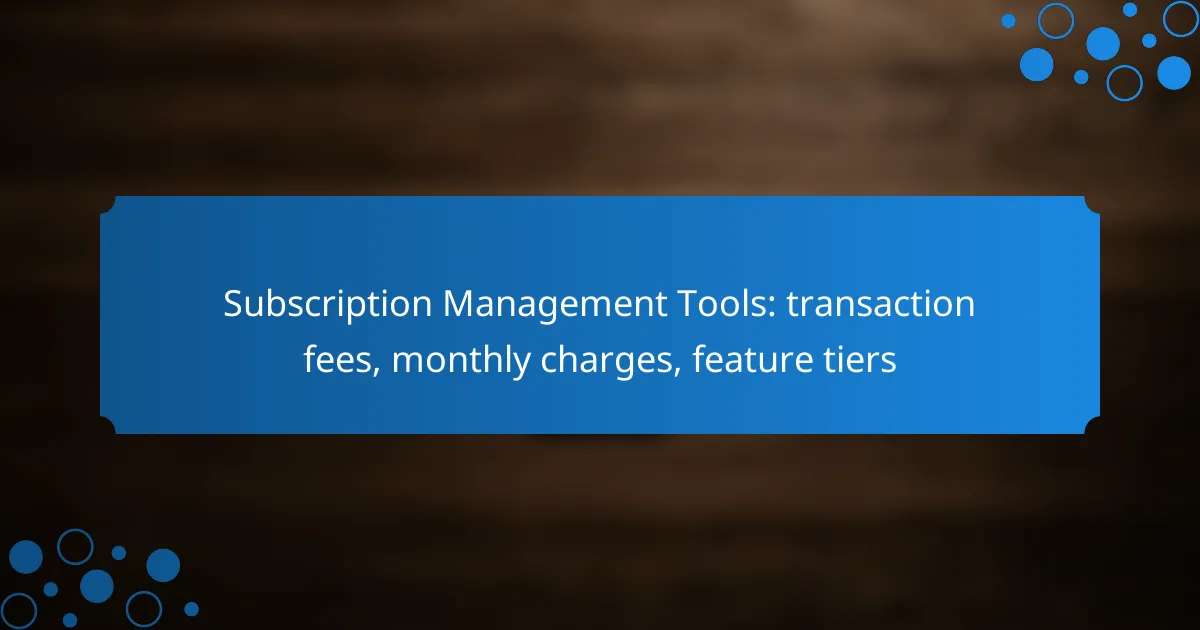Subscription management tools are essential for businesses looking to streamline their billing processes and effectively manage customer subscriptions. When choosing a tool, it’s important to consider transaction fees, monthly charges, and the varying features available at different pricing tiers to ensure optimal profitability and service quality.
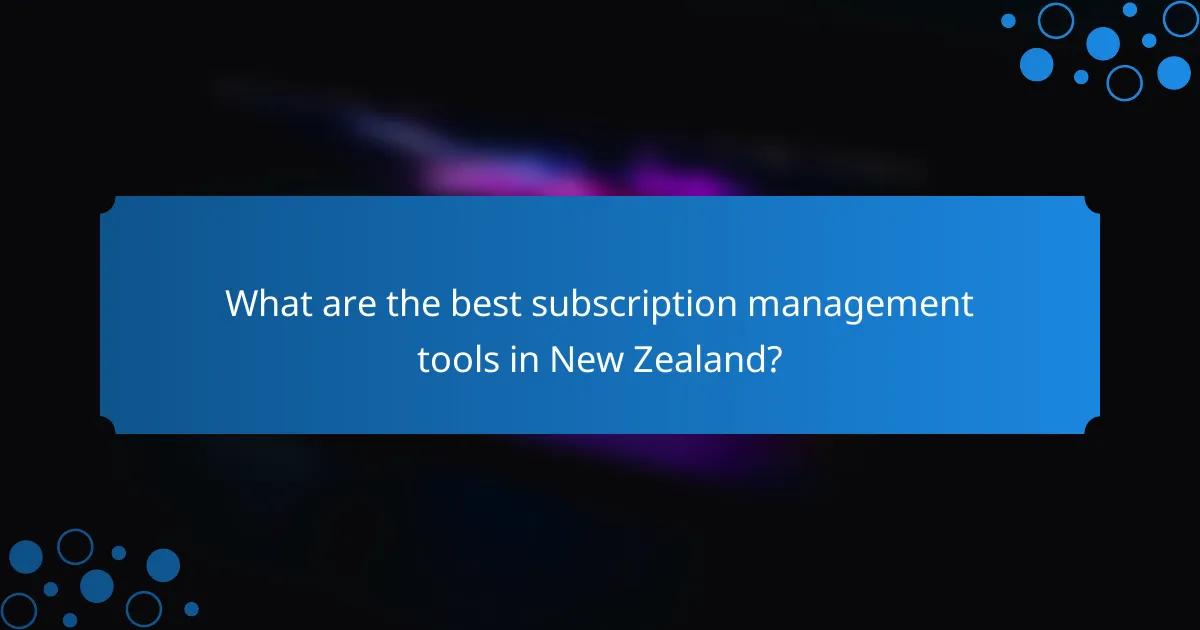
What are the best subscription management tools in New Zealand?
The best subscription management tools in New Zealand streamline billing processes, manage customer subscriptions, and handle transactions efficiently. Key factors to consider include transaction fees, monthly charges, and the features offered at different pricing tiers.
Chargebee
Chargebee is a robust subscription management platform that caters to businesses of all sizes. It offers features like automated billing, invoicing, and revenue recognition, making it suitable for companies looking to simplify their subscription processes.
Pricing for Chargebee typically starts with a free tier for small businesses, while paid plans can range from NZD 300 to NZD 1,200 per month, depending on the features required. Be mindful of transaction fees that may apply based on your payment processor.
Recurly
Recurly provides a comprehensive solution for managing subscriptions, including features such as dunning management and analytics. It is particularly beneficial for businesses that need to optimize their revenue and reduce churn rates.
Recurly’s pricing is based on a percentage of revenue, usually around 1% to 2%, plus a monthly fee that can vary from NZD 200 to NZD 1,000. Consider the total cost of ownership, including transaction fees, when evaluating this tool.
Zuora
Zuora is designed for larger enterprises that require advanced subscription management capabilities. It supports complex billing scenarios and offers extensive reporting features to help businesses track performance.
Zuora’s pricing is not publicly listed, as it typically requires a custom quote based on the specific needs of the business. Expect to consider both monthly fees and transaction costs, which can add up significantly for high-volume businesses.
Stripe Billing
Stripe Billing is part of the Stripe payment processing platform and offers seamless integration for subscription management. It allows businesses to create and manage subscriptions, handle invoicing, and track revenue easily.
Stripe charges a flat fee of around 2.9% + NZD 0.30 per transaction, making it a cost-effective option for many businesses. Monthly charges are generally minimal, focusing on transaction-based pricing, which can be advantageous for startups and small businesses.
PayPal Subscriptions
PayPal Subscriptions enables businesses to set up recurring payments and manage customer subscriptions through the PayPal ecosystem. It is widely recognized and trusted by consumers, which can enhance customer confidence.
PayPal typically charges around 2.9% + NZD 0.30 per transaction, with no monthly fees for basic subscription services. However, businesses should be aware of potential additional fees for advanced features or higher transaction volumes.
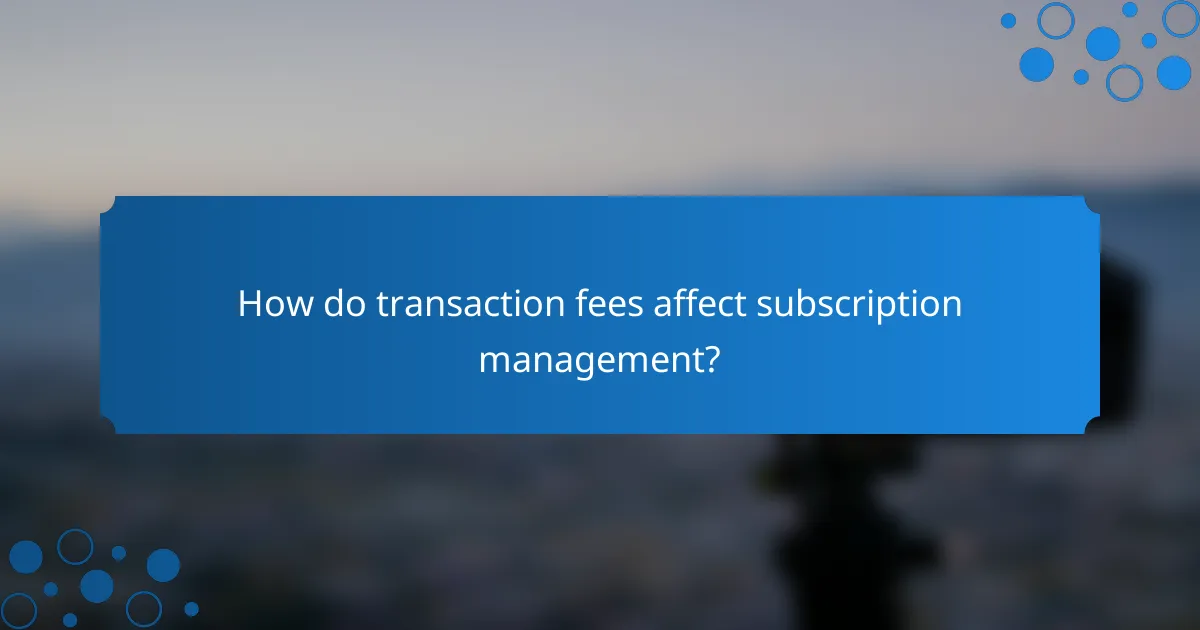
How do transaction fees affect subscription management?
Transaction fees can significantly impact subscription management by affecting overall profitability and pricing strategies. Understanding how these fees work is essential for businesses to optimize their subscription models and maintain competitive pricing.
Percentage-based fees
Percentage-based fees are calculated as a percentage of each transaction, which means they scale with the transaction amount. For example, if a subscription service charges a 3% fee on a $10 subscription, the fee would be $0.30 per transaction. This model can benefit businesses with lower-priced subscriptions, as the fees remain manageable.
However, as subscription prices increase, percentage-based fees can become a significant expense. Businesses should evaluate their pricing tiers to ensure that these fees do not erode profit margins, especially for higher-priced offerings.
Flat-rate fees
Flat-rate fees charge a fixed amount per transaction, regardless of the transaction size. For instance, a subscription service might pay a flat fee of $1 per transaction, which can simplify budgeting and forecasting. This model is advantageous for businesses with predictable transaction volumes.
On the downside, flat-rate fees can be less favorable for lower-priced subscriptions, as the fee may represent a larger percentage of revenue. Companies should analyze their pricing structure to determine if a flat-rate fee aligns with their financial goals.
Impact on pricing strategy
Transaction fees directly influence pricing strategies, as businesses must account for these costs when setting subscription prices. To maintain profitability, companies often increase subscription fees to offset transaction costs, which can affect customer retention and acquisition.
It is crucial to strike a balance between competitive pricing and covering transaction fees. Businesses should consider offering tiered pricing models that reflect the value provided at different levels while keeping transaction fees in mind. Regularly reviewing and adjusting pricing strategies in response to changes in transaction fees can help maintain a healthy profit margin.
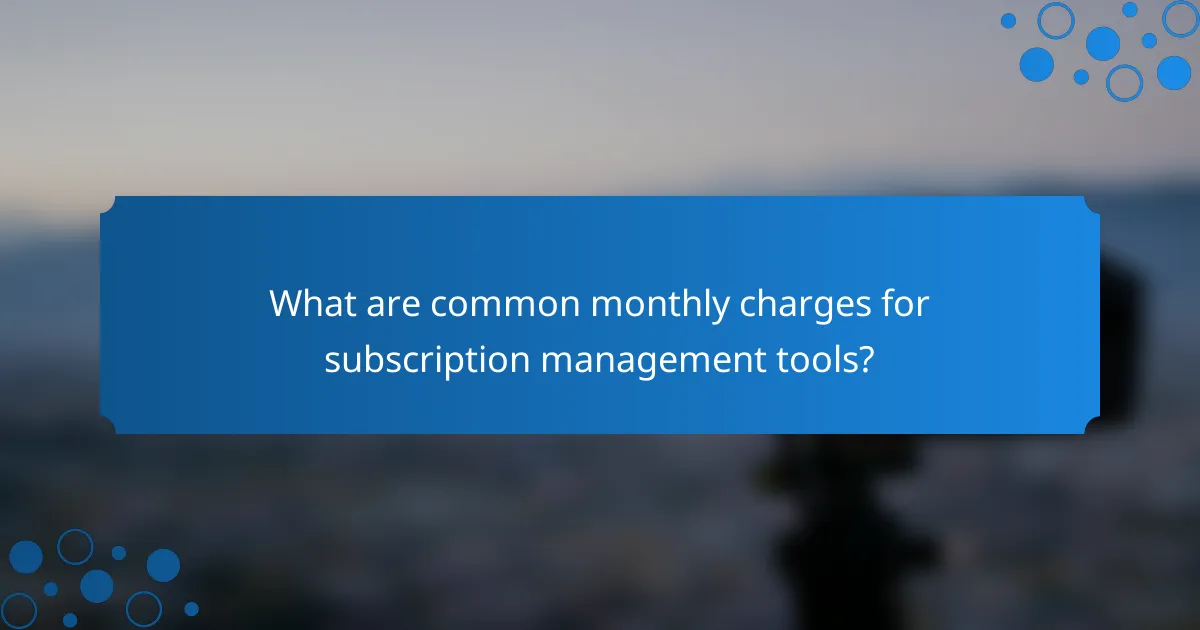
What are common monthly charges for subscription management tools?
Monthly charges for subscription management tools typically range from $50 to $500, depending on the features and service levels offered. Basic plans often include essential functionalities, while premium plans provide advanced features suitable for larger businesses.
Basic plans starting at $50
Basic subscription management plans generally start around $50 per month and are ideal for small businesses or startups. These plans usually cover essential features such as billing, invoicing, and basic reporting.
When selecting a basic plan, consider the number of users and transactions included, as some providers may charge extra for additional users or higher transaction volumes. Always review the features to ensure they meet your business needs.
Premium plans up to $500
Premium subscription management plans can cost up to $500 per month and are designed for larger organizations with more complex requirements. These plans often include advanced features such as automated workflows, detailed analytics, and integrations with other software.
Investing in a premium plan can provide significant benefits, such as improved efficiency and better customer insights. However, assess whether your business will fully utilize these advanced features to justify the higher cost.
Usage-based pricing models
Some subscription management tools offer usage-based pricing models, where charges are based on the actual usage of the service rather than a flat monthly fee. This can be advantageous for businesses with fluctuating transaction volumes.
With usage-based pricing, you pay for what you use, which can lead to lower costs during slower periods. However, it is essential to monitor usage closely to avoid unexpected charges, especially during peak times.
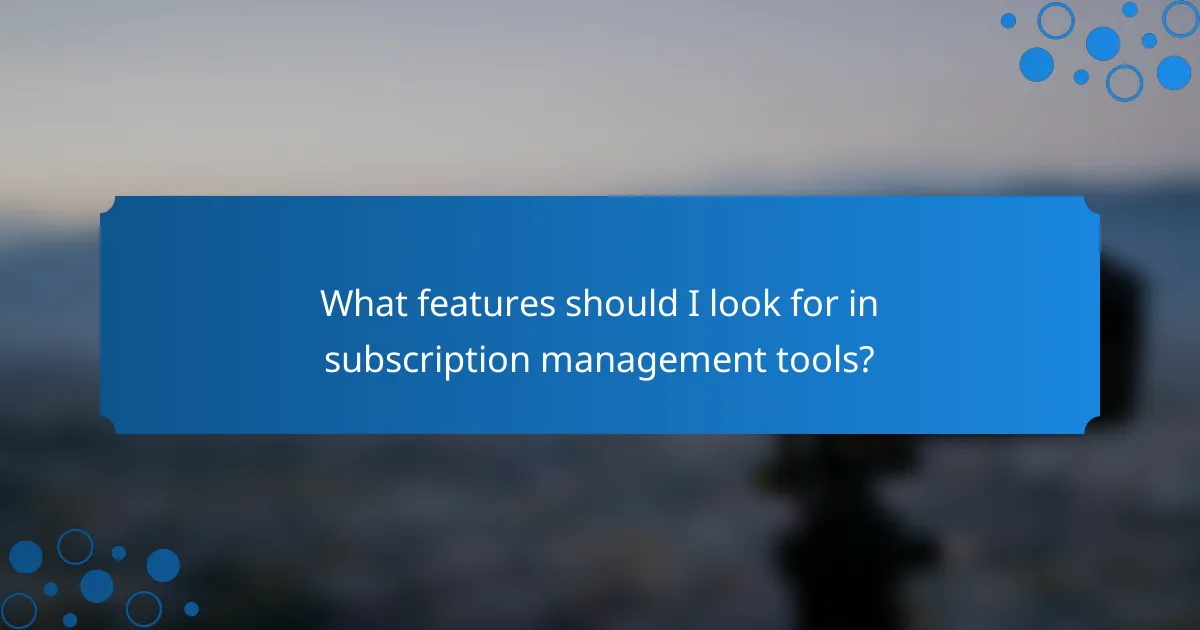
What features should I look for in subscription management tools?
When selecting subscription management tools, focus on features that streamline billing, provide insightful analytics, and offer robust integration options. These capabilities enhance operational efficiency and improve customer experience.
Automated billing
Automated billing is essential for managing recurring payments without manual intervention. Look for tools that support multiple payment methods, such as credit cards and digital wallets, to accommodate diverse customer preferences.
Consider features like customizable billing cycles and automated invoicing, which can reduce administrative workload. Ensure the tool can handle various currencies if you operate internationally, as this will simplify transactions for your global customers.
Analytics and reporting
Analytics and reporting features provide valuable insights into subscription performance, customer behavior, and revenue trends. Choose tools that offer real-time dashboards and customizable reports to track key metrics like churn rate and customer lifetime value.
Effective reporting can help identify areas for improvement, such as pricing adjustments or upselling opportunities. Look for tools that allow you to segment data by customer demographics or subscription tiers for more targeted analysis.
Integration capabilities
Integration capabilities are crucial for ensuring your subscription management tool works seamlessly with existing systems like CRM, accounting, and marketing platforms. Evaluate tools that offer APIs or pre-built integrations to facilitate data flow between applications.
Consider the ease of integration and the level of support provided by the tool’s vendor. A well-integrated system can enhance operational efficiency and provide a unified view of customer interactions across different channels.

How do feature tiers vary among subscription management tools?
Feature tiers among subscription management tools can significantly impact the functionality and pricing of the service. Basic tiers typically offer essential features, while advanced tiers provide more comprehensive capabilities, catering to different business needs and budgets.
Basic vs. advanced features
Basic features in subscription management tools often include functionalities like billing, invoicing, and basic reporting. These are suitable for small businesses or startups that require straightforward subscription handling without complex needs.
Advanced features, on the other hand, may encompass analytics, customer segmentation, automated workflows, and integrations with other software. Businesses with larger customer bases or more complex subscription models usually benefit from these enhanced capabilities, which can justify higher monthly charges.
Customizable options
Many subscription management tools offer customizable options that allow businesses to tailor their services according to specific requirements. Basic tiers may provide limited customization, while advanced tiers often include extensive options for branding, user interface adjustments, and tailored reporting.
When selecting a tool, consider how much customization you need. If your business model is unique, investing in a tool with robust customizable features can lead to better user experiences and operational efficiencies.
Support and service levels
Support levels can vary widely between basic and advanced tiers. Basic plans may offer limited support, such as email assistance or access to online resources, which might suffice for smaller operations.
In contrast, advanced tiers typically include dedicated account managers, priority support, and personalized onboarding services. This level of support can be crucial for larger organizations that require immediate assistance and guidance to optimize their subscription management processes.

What are the prerequisites for choosing a subscription management tool?
Choosing a subscription management tool requires understanding your business needs, budget constraints, and the features that will best support your operations. Key considerations include transaction fees, monthly charges, and the specific features offered at various pricing tiers.
Business size considerations
Your business size significantly influences the choice of a subscription management tool. Smaller businesses may prioritize affordability and basic features, while larger enterprises often need advanced functionalities and scalability. For example, a startup might opt for a tool with lower monthly charges and essential features, while a mid-sized company may require more robust reporting and analytics capabilities.
When evaluating options, consider the number of subscriptions you manage and the expected growth. Tools that charge based on transaction volume or the number of active subscriptions can become costly as your business scales. Aim for a solution that offers tiered pricing, allowing you to upgrade features as your needs evolve without incurring excessive costs.
It’s also wise to assess the integration capabilities of the tool with your existing systems. Larger businesses often have complex workflows that necessitate seamless integration with CRM, accounting, and marketing platforms. Ensure the tool you choose can accommodate these needs without requiring significant additional investment.
